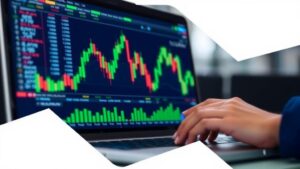Highlighting the Shift to Algorithmic Approaches
In today’s fast-paced financial landscape, automated decisions are no longer a luxury—they’re a necessity for savvy investors.
Algorithmic trading, often referred to as “algo trading,” is the use of computer programs and algorithms to execute trading orders based on predefined criteria. The primary goal is to maximize profit while minimizing risk by making trades at optimal times. These algorithms can analyze vast amounts of data and execute orders at speeds far beyond human capabilities.
Key Components of Algorithmic Trading
- **Algorithms**: Instructions programmed into a computer that dictate how and when trades should be made based on specific market conditions.
- **Market Data**: Real-time data from various financial markets, including prices, volume, and other relevant metrics, that inform trading decisions.
- **Execution Systems**: Platforms that enable the automated execution of trades. These systems can connect directly to stock exchanges or trading venues.
Types of Algorithmic Trading Strategies
Algorithmic trading encompasses a wide range of strategies, each designed to achieve specific goals. Here are some common types:
1. Execution Algorithms
Execution algorithms focus on executing large orders without significantly impacting the market price. They strive to achieve the best execution price while minimizing market impact. Examples include:
- VWAP (Volume Weighted Average Price)**: This strategy aims to execute orders at an average price weighted by volume over a specific time period.
- TWAP (Time Weighted Average Price)**: This strategy breaks up large orders and executes them evenly over a specified time frame, minimizing the market impact.
2. Trend-Following Strategies
These strategies are based on the idea that assets that have been moving in a particular direction will continue to do so. Traders utilize various indicators to identify trends, including:
- Moving Averages**: Traders might buy when the short-term moving average crosses above the long-term moving average, indicating an upward trend.
- Momentum Indicators**: Tools like the Relative Strength Index (RSI) help traders identify overbought or oversold conditions, signaling potential trend reversals.
3. Arbitrage Strategies
Arbitrage strategies capitalize on price discrepancies between different markets or related instruments. These strategies are often executed quickly to take advantage of fleeting opportunities. Types include:
- Statistical Arbitrage**: This involves identifying pairs of correlated stocks and trading them based on their relative price movements.
- Cross-Market Arbitrage**: Traders exploit price differences between different exchanges or markets for the same asset.
4. Market Making
Market-making strategies involve providing liquidity to the markets by simultaneously placing buy and sell orders. Market makers earn profits from the bid-ask spread. Key features include:
- High-Frequency Trading**: This involves executing numerous trades at extremely high speeds, often holding positions for mere seconds or milliseconds.
- Spread Management**: Market makers adjust their bids and asks based on market conditions to maintain profitability.
Advantages of Algorithmic Trading
Algorithmic trading offers several benefits that have contributed to its growing popularity among traders and institutions alike:
1. Speed and Efficiency
- Algorithms can process vast amounts of market data and execute trades in milliseconds, allowing traders to capitalize on fleeting opportunities.
- Automated systems eliminate the delays associated with manual trading, ensuring timely execution of orders.
2. Reduced Emotional Trading
- By relying on algorithms, traders can mitigate emotional decision-making, which is often driven by fear and greed.
- Algorithms follow predefined rules, leading to more disciplined trading behavior.
3. Enhanced Accuracy
- Algorithms can analyze multiple parameters simultaneously, leading to more informed trading decisions.
- Automated trading reduces the likelihood of human error, such as miscalculations or typos.
Challenges of Algorithmic Trading
While algorithmic trading offers numerous advantages, it also comes with its own set of challenges:
1. Technical Risks
- System Failures**: Technical glitches or system failures can lead to significant losses or missed opportunities.
- Latency Issues**: Delays in data transmission or execution can result in suboptimal trade performance.
2. Market Risks
- Volatility**: Sudden market changes can lead to unexpected losses, particularly for high-frequency trading strategies.
- Liquidity Risk**: In times of market stress, algorithms might struggle to execute trades at expected prices.
3. Regulatory Compliance
- Algorithmic trading is subject to various regulations, which can vary by jurisdiction. Staying compliant is crucial to avoid penalties and ensure fair trading practices.
Real-World Applications of Algorithmic Trading
Algorithmic trading strategies are employed across various sectors, including:
1. Institutional Trading
- Large financial institutions and hedge funds utilize sophisticated algorithms to manage large portfolios and execute complex trading strategies efficiently.
2. Retail Trading
- Retail traders are increasingly leveraging algorithmic trading tools to enhance their trading strategies and compete with institutional players.
3. Cryptocurrency Trading
- The rise of cryptocurrencies has also seen algorithmic trading flourish, with traders using bots to capitalize on price volatility and market inefficiencies.
Conclusion
Algorithmic trading has revolutionized the financial markets, offering traders the ability to make more informed, efficient, and disciplined decisions. By understanding the various strategies, advantages, and challenges associated with algorithmic trading, individuals and institutions can better navigate this complex landscape. As technology continues to evolve, so too will the strategies employed by traders, making it imperative to stay informed and adaptable in this dynamic environment. Whether you are a novice or an experienced trader, embracing algorithmic trading strategies could be the key to unlocking your full trading potential.



